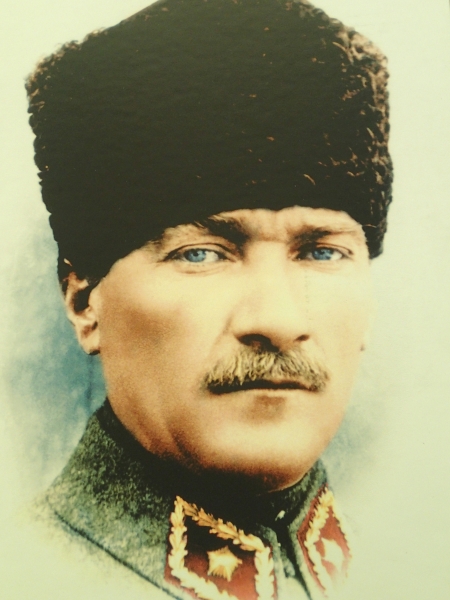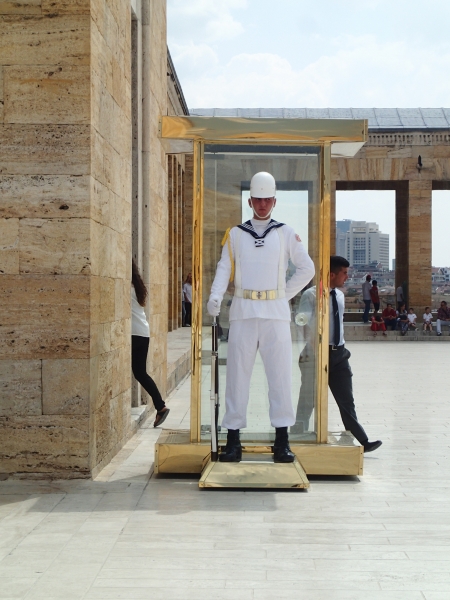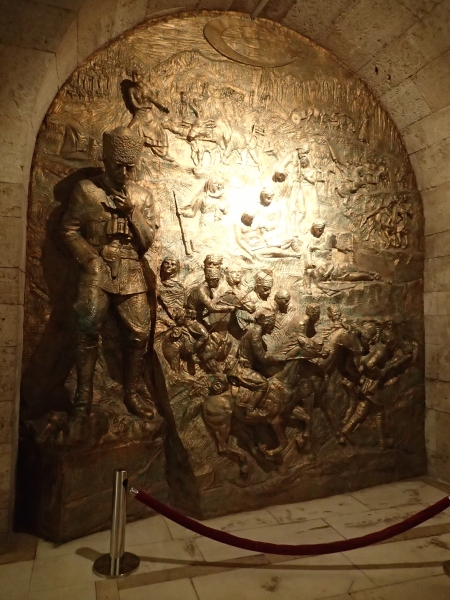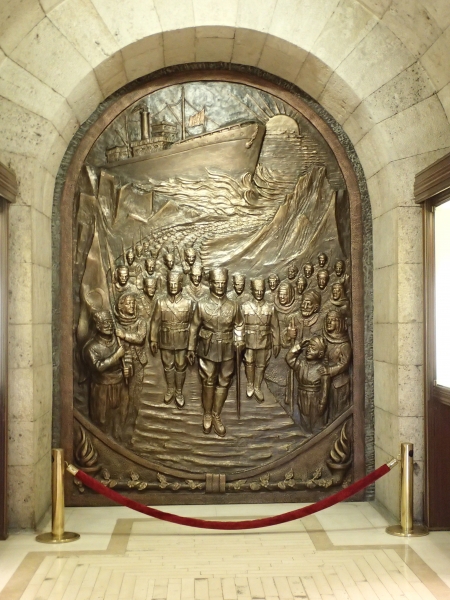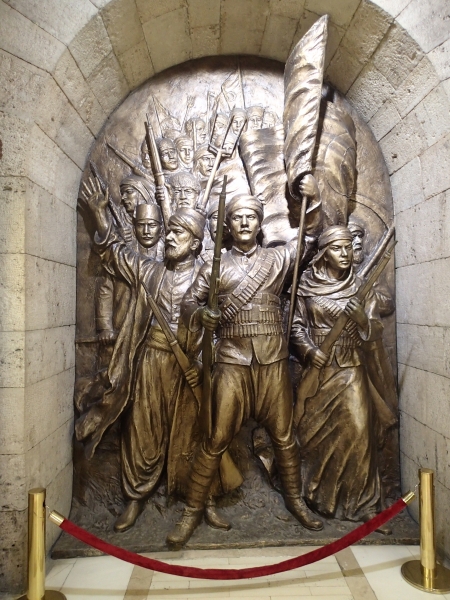Anıtkabir (literally, “memorial tomb”) is the mausoleum of Mustafa Kemal Ataturk (Pasha). It was designed by architects Professor Eminent Onat and Assistant Professor Ahmet Orhan Arda, who won a government competition in 1941 for the design of a “monumental tomb” for Atatürk. The site is also the final resting place of Ismet Inonu, the second President of Turkey who was interred there in 1973. His tomb faces the Atatürk Mausoleum, on the opposite side of the Ceremonial Ground. The mausoleum was depicted on various Turkish banknotes during 1966–1987 and 1997–2009.
Mustafa Kemal (Pasha) Atatürk (born 19 May 1881 in Salonika Vilayet Ottoman Empire, now Thessaloniki, Greece) was a revolutionary who became the first president of Turkey and held office from 29th Oct 1923 until his death on 10 Nov 1938 at Dolmabahce Palace, Istanbul. He died from complications of cirrhosis of the liver. He is credited as being the founder of the Republic of Turkey. His surname, Ataturk means “Father of Turks” was granted in 1934 and forbidden to be used by anyone else under Turkish law. Atatürk’s funeral raised both sorrow and pride in Turkey, and 17 countries sent special representatives, while nine contributed armed detachments to the cortege. His remains were originally laid to rest in the Ethnography Museum of Ankara but were transferred on 10 November 1953, 15 years after his death in a 42-ton sarcophagus to the Anitkabir.
His father was a minor official and later a timber merchant. When Atatürk was 12, he was sent to military school and then to the military academy in Istanbul, graduating in 1905. In 1911, he served against the Italians in Libya and then in the Balkan Wars (1912 – 1913). He made his military reputation repelling the Allied invasion at the Dardanelles in 1915. In May 1919, Atatürk began a nationalist revolution in Anatolia, organising resistance to the peace settlement imposed on Turkey by the victorious Allies. This was particularly focused on resisting Greek attempts to seize Smyrna and its hinterland. Victory over the Greeks enabled him to secure revision of the peace settlement in the Treaty of Lausanne.
He was a highly decorated military officer during WWI and following the defeat of the Ottoman Empire he led the Turkish National Movement in the Turkish War of Indepencence. He established a provisional government in Ankara and defeated the allied forces…..that includes us!
In Australia, the Kemal Atatürk Memorial is directly opposite the Australian War Memorial on Anzac Parade, the principal memorial and ceremonial parade in our capital, Canberra. It is named after Mustafa Kemal (1881–1938) who then, as a Lieutenant Colonel, commanded the Turkish 19th Infantry Division when it resisted the Australian and New Zealand Army Corps (ANZAC) at Ari Burnu, on the Gallipoli peninsula, in 1915 during WWI. In 1985, seventy years after the Gallipoli campaign, the Turkish Government agreed to recognise the name “ANZAC Cove” for the place on the peninsula where our troops landed on 25 April 1915. In return for this gesture, the Australian Government established the memorial garden, around the Kemal Atatürk Memorial, that honours the heroism and self-sacrifice of the Turkish and ANZAC soldiers who took part in that bitterly fought campaign. This is the only memorial to an enemy commander on Anzac Parade. Closer to home in Western Australia, as part of the same reciprocal agreement in 1985, the channel leading into Princess Harbour in Albany (were our troups sailed from) was officially named “Ataturk Channel” whilst the Turkish Government officially named the beach at Gallipoli, “Anzac Cove”. In 2002, a life size statue of Mustafa Kamal Atatürk was erected overlooking this Channel on the scenic boardwalk leading from Albany to Middleton Beach. Access to the memorial is from the beach side at Ellen Cove Boardwalk (Middleton) or walking along Stirling Terrace from the CBD.
In 1921, Atatürk established a provisional government in Ankara. The following year the Ottoman Sultanate was formally abolished and, in 1923, Turkey became a secular republic with Atatürk as its president. He established a single party regime that lasted almost without interruption until 1945. After winning the War of Independence , he launched a programme of revolutionary social and political reform to modernise Turkey. These reforms included the emancipation of women, the abolition of all Islamic institutions and the introduction of Western legal codes, dress, calendar and alphabet, replacing the Arabic script with a Latin one. Abroad he pursued a policy of neutrality, establishing friendly relations with Turkey’s neighbours. He wanted to transform the former Ottoman Empire into a modern and secular nation-state. Under his leadership, thousands of new schools were built, primary education was made free and compulsory, and women were given equal civil and political rights. The principles of his reforms upon which modern Turkey was established, are referred to as Kemalism.
The Anıtkabir museum is composed of three sections. The first section is the Atatürk Museum, in which are exhibited Atatürk’s civil and official clothes, his personal belongings, various gifts presented to him, and many assorted documents and photos. The second section depicts the Çanakkale (Dardanelle) War. Audiovisual effects and objects such as rocks, cannons, rifles, guns and shells have been added to this section in order to give a 3 dimensional effect. The other panoramas depicting the Sakarya Meydan Savaşı and Büyük Taarruz (two of the most important battles of the War of Independence) have also been displayed in the same way. The third section is composed of recreations of events that took place from the time of the War of Independence (1919) until the death of Ataturk (1938).
Vince and I have been totally stunned at the number and variety of generations of people visiting (many local) and in general the great esteem with which this man is obviously revered throughout our travels through Turkey….his portraits and statues are everywhere. I read that each year at the exact time of his death, on every 10 November, at 09:05 am, vehicles and people in the country’s streets pause for one minute in remembrance….having seen the spectacle today, I can well believe it. Never have we seen such pride, idealisation and devotion to a public figure so openly displayed and widespread throughout a nation.

